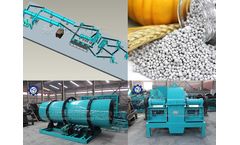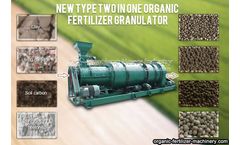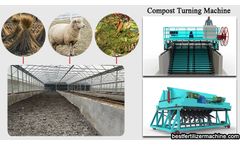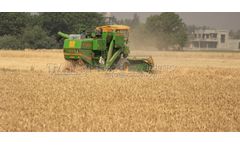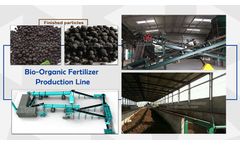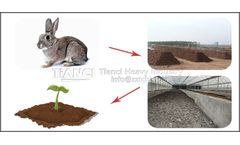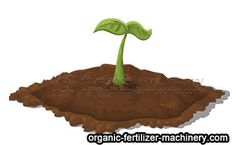Refine by
Humus Articles & Analysis
28 articles found
Compost fermentation is to use the oxidative decomposition ability of natural microorganisms to controllably promote the biochemical degradation of degradable organic matter in the material under a certain temperature, humidity and pH value to form stable humus. This process can effectively deal with the organic matter in the material and kill harmful substances such as ...
Decomposition of the organic waste into humus or compost using a Waste Composter device. What is the difference between compost and Topsoil? ...
According to the opinion of other experts, impoverished soils occupy much bigger area and consist about 15 million hectares. The decrease in the amount of humus and the general deterioration of land is caused both by climatic conditions changes and, for the most part, the negligent attitude of tenants and owners. ...
The humus in organic fertilizer increases the content of soil organic matter, which is beneficial to the formation of good soil structure, especially the increase of water stable aggregate structure, so as to improve the tightness, aeration, water retention and heat status of soil, and has a good effect on the water, fertilizer, air and heat conditions that determine the soil ...
The use of aerobic microorganisms decomposes complex organic matter into stable humus, and generates heat energy. The internal temperature of feces increases gradually, reaching 60-70% high temperature, and can last for several days. ...
During the composting process, the chemical composition of nutrient differentiation changes, the carbon to nitrogen ratio decreases, the mineral nutrients directly absorbed by plants increase, and humus is formed. The decomposed compost is suitable for processing high-quality organic fertilizer with a fertilizer ...
The pre-treatment of organic fertilizer production line mainly utilizes the function of various microorganisms to mineralize, humify and innocuously plant organic residues, so as to transform various complex organic nutrients into soluble nutrients and humus. At the same time, the high temperature produced during accumulation is used to kill the germs, eggs and weed seeds in raw ...
In the later stage, microorganisms can only produce humus of organic matter, in which a large number of metabolites are produced, which are beneficial to plant growth and absorption. ...
Maturity refers to the process of organic matter that is not easily decomposed (such as manure, straw, fallen leaves, weeds), etc. after fermentation to rot into effective fertilizer and humus. Because fresh rabbit manure has a high water content, a bad smell, and contains a lot of eggs and debris, untreated fresh rabbit manure is used directly, and the harm is greater than the ...
Soil organic matter releases a large number of nutrients through the mineralization process to provide nutrients for plant growth; humification synthesizes humus and saves nutrients, and humus releases nutrients again through the mineralization process, thereby ensuring nutrient requirements throughout the plant growth process. 2. ...
Humic acids or humus are black or dark brown substances formed by plant or animal residues that are partially or completely decayed. Humus is a substance that facilitates the uptake of fertilizers. Today, the increasing use of chemical fertilizers causes the humus in our land to be rapidly depleted. ...
To grow great plants, fruits and vegetables, long-lived ornamental trees, shrubs, and abundant flowers, you need to have your garden soil rich in all the required nutrients and humus, which can only be achieved with the help of Natural of Organic Fertilizers. ...
The use of organic fertilizer can enhance soil fertility conservation and buffer capacity. Humus is an organic colloid with a large surface area. Its water absorption capacity is more than 100 times larger than that of inorganic colloids and its replacement capacity is 4 times larger than that of inorganic colloids. ...
By composting and recycling, less yard waste, kitchen vegetables, and fruits scraps, are going into landfills, and the organic humus is going back into your garden. Develop a routine of adding material to your compost every day by following a routine of emptying your kitchen compost container, followed by your chicken coop muck bucket, and adding these materials to your ...
Modern investigations have confirmed the usefulness of earthworms: in healthy meadowland, up to 500 earthworms work per square meter of ground and produce up to 60 kilograms of humus a year. Earthworms perform high-quality recycling and refining of plant and animal residues in their gut. ...
Hazardous chemicals or synthetic materials are not used within the matrix, and over time, coir completely disintegrates, leaving only humus, which enriches the soil! For more details on our natural, environmentally friendly coir products, their usages and how CoirGreen™ work, please visit - http://www.coirgreen.com or simply email us on ...
Vermicomposting of mustard (Brassica juncea) residue with pretreatments of submergence in water, nutrients (urea and low grade rock phosphate) supplementation, microbial (Bacillus sp., Trichoderma viride and Cellulomonas fimi) inoculation and their combined use with fresh cow dung/slurry improved the quality of vermicomposts with respect to C/N ratio, yield, humus fractions and ...
Earthworms can treat organic garbage, livestock manure and poultry droppings and turn them into premium organic fertilisers, because humus only exists in earthworm feces and castings, compared with other fertilisers. ...
The main objective of this work was to study the effect of incorporating two vermicomposts of different chemical nature (cow dung, CD; and green forages, GF) at rates of 3 and 6 t C ha–1, respectively, on soil biological properties (soil microbial biomass, soil respiration and soil enzymatic activities), soil humus–enzymes complexes, nutrition (N, P, and K plant contents, ...
Estimates of C and N stocks based on DSS were compared with those estimated by SRS in the humus forms of Douglas-fir [Pseudotsuga menziesii (Mirb.) Franco] stands in the Cascade Mountains of Oregon. ...

